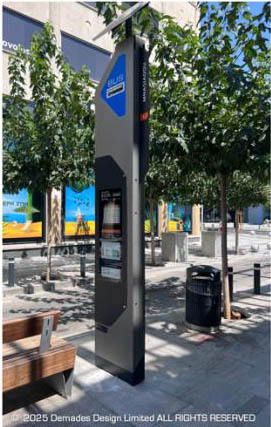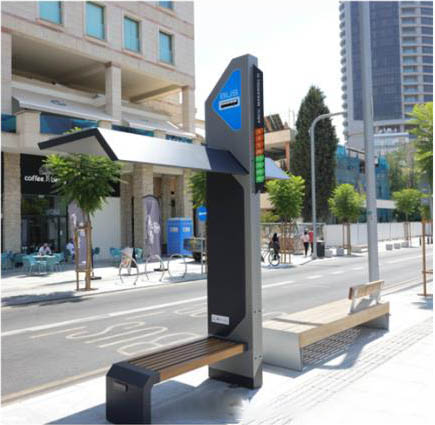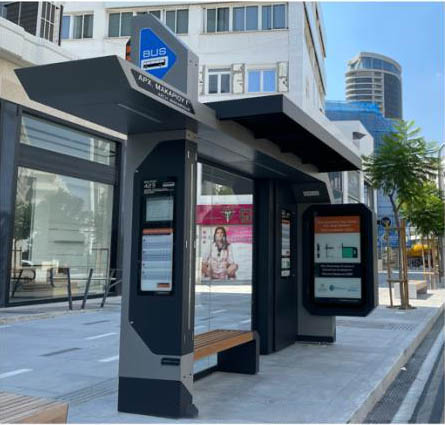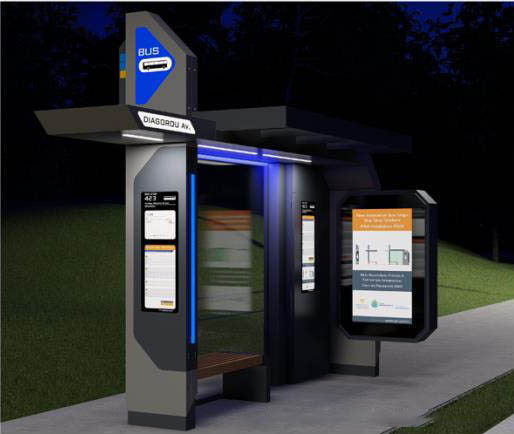The Smart Bus Stop and Shelter System, which was developed after winning the tender announced by the Ministry of Transport in 2018, has been delayed. To date, only a small number of the smaller Type B canopies have been installed, with some features missing.
As explained to "F" by Mr. Nikolas Dimadis, of the company Demades Design, which won the design competition of the project, the fact of the delay and the installation of a small number of shelters has caused confusion to the public, as the full potential of the Smart Bus Stop System has not yet been implemented.
In addition, there has been confusion about the orientation of bus stops and the location of the main pillar of the stop . However, as Mr. Dimadis explains, the design specifications given required the pillar to be placed on the left side, so that it would act as an indication for the bus driver about where to stop. "Demades Design remains committed to supporting the successful implementation of this transformative project, which has the potential to redefine public transport in Cyprus and improve the passenger experience," he adds.

Mr. Dimadis says that this innovative project is an important step towards the modernization of public transport in Cyprus, incorporating cutting-edge technologies and sustainable design principles.
Demades Design was founded in 2001 by Nikolaos Dimadis, a mechanical engineer and industrial/automotive designer, with experience at Alfa Romeo's Centro Stile in Milan and Mercedes-Benz's Advanced Design Studio in Como, Italy. With more than 280 completed projects, such as e-charge electric car charging stations for EAC and Fillngo petrol stations, the company is a pioneer in the field of design and innovation.
Referring to the specific project of the stops, Mr. Dimadis notes that the construction of the stops was assigned to a local construction company through a tender on October 5, 2023. The Ministry of Transport's announcement called for the design of a Smart Unit Bus Stop System, which could be implemented throughout Cyprus, supporting the transition to a modern, technology-oriented public transport system. The result is a flexible and scalable design that meets the needs of urban, rural and mountainous areas by incorporating advanced smart technologies.

The design philosophy
The design, as Mr. Dimadis explains, is inspired by the dynamic and functional shape of the "arrow", which symbolizes progress and movement. This unit system offers flexibility, adaptability and ease of maintenance, with a durable metal frame and replaceable exterior panels. The design also allows for the future integration of advanced technologies, such as cameras with artificial intelligence capabilities.

The system includes several configurations to meet different locations and passenger needs:
- Type A: Column sign – Designed for areas with low passenger traffic, it replaces traditional stop signs with a tower sign that provides real-time information on the arrival of buses. It also includes a visual and audio notification system for the arrival of a bus.
- Type B: Small canopy with seats – Ideal for areas with low traffic or confined spaces, such as old city centers or narrow streets.
- Type C: Main bus stop canopy – Designed for major urban arteries, includes information screens, arrival notifications, timetables, night lighting, seating, wheelchair access, and solar system. It also incorporates a visual and audio bus arrival notification system.
- Type C/Mountainous – Special version of Type C for mountainous areas, with additional weather protection through front and side panels.
- Types D and E: Extended Canopies – Larger canopies for areas with high passenger traffic, offering extra seats and covered waiting space.
- Bicycle racks and canopies – To promote sustainable mobility, the project also includes the design of bicycle racks and canopies that will be installed alongside the bus stops.

Technologies and features
The Smart Bus Stop System incorporates a number of innovative technologies and features:
- Unit design for scalability and adaptability.
- Space Frame Technology: Durable steel frame with lightweight, replaceable aluminium panels.
- Graffiti protection.
- Built-in seats with wooden boards.
- Double-sided illuminated signs for clear route identification.
- Night lighting for increased safety.
- Smart solar systems for lighting and information management.
- Illuminated route maps and timetables.
- Visual and audio bus arrival notification system.
- Interactive passenger information screens using a special e-paper screen.


Prototypes and application
Following the approval of the final design by the Ministry of Transport, prototypes of the three main types (Type A, Type B and Type C) were manufactured by Demades Design and installed in the Nicosia shopping centre on Makariou Avenue. These prototypes have been operating since their official presentation on August 1, 2022, demonstrating the characteristics of the system in real conditions, concludes Mr. Dimadis.
